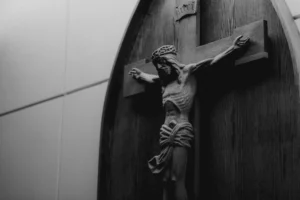Three rings for the Elven — kings under the sky,
Seven for the Dwarf — lords in their halls of stone,
Nine for Mortal Men doomed to die,
One for the Dark Lord on his dark throne
In the Land of Mordor where the Shadows lie.
One ring to rule them all,
One ring to find them,
One ring to bring them all and in the darkness bind them
In the Land of Mordor where the Shadows lie.
– J.R.R. Tolkien, The Lord of the Rings
When the most awaited film since The Phantom Menace opened yesterday in more than 3,500 theaters across the country, I couldn’t miss it. That film, of course, was The Lord of the Rings: the Fellowship of the Ring.
As you likely know, the film is an adaptation of J.R.R. Tolkein’s book by the same name. John Ronald Reuel Tolkien was a professor of Anglo-Saxon studies and English literature at Oxford from 1925 to 1959. While at Oxford, he made the acquaintance of a young don named Clive Staples Lewis — Jack to his friends. As C.S. Lewis writes in his biography Surprised by Joy, Tolkien was instrumental in Lewis’ conversion from atheism to theism and then to Christianity.
In 1937, Tolkien published a novel called The Hobbit. In it, Tolkien depicted a fantastic (in its literal sense) world known as “Middle Earth.” The “middle” describes not so much geography as an imaginary epoch. It’s a world where men, whose time has not yet come, live alongside wizards, elves, dwarves and hobbits. The latter are, in Tolkien’s memorable description of “halflings,” no more than 3 feet tall and quite content to live their lives out in their beloved Shire. They love good food, good drink, good stories and a good pipe.
The Hobbit served as a prequel to something much bigger — both in terms of length and impact. For the next decade, Tolkien worked on Lord of the Rings, a three-part story about a ring that gave its bearer the power to enslave all of Middle Earth. After being lost for many generations, the ring eventually came into the possession of Frodo Baggins, a hobbit. Much to his dismay, he learns that he must leave the Shire and embark on a quest to destroy the ring by returning to the fires from which it was forged.
The first part of that story, The Fellowship of the Ring, was published in 1954, with the other parts, The Two Towers and The Return of the King following the next year. While Tolkien’s publisher liked the novel, he feared it would be a flop. It didn’t quite turn out that way. Initially, the novel sold respectably. Then, as its reputation spread to American college campuses, it zoomed past commercial success to become a cultural phenomenon. To date, the novel has sold more than 100 million copies worldwide.
But numbers alone can’t begin to describe the hold Tolkien’s opus has on its readers. In 1965, a high school student left a message, written in the Elf language (Quenya) Tolkien invented for the Lord of The Rings on the subway walls near Columbia University. It announced that the Tolkien Club would meet in front of Columbia’s alma mater statue in a week’s time. Despite typically freezing February New York weather, six folks showed up in response to an announcement that wasn’t even written in a real language. This exemplified the Lord of The Rings mania that seized the imagination of a generation. You couldn’t go anywhere near an American college campus in the 1960s without seeing bumper stickers that proclaimed “Frodo Lives!” or “Visit Middle Earth.”
This response to Tolkien’s work, which has progressed from bumper stickers to thousands of websites and discussion groups, attests to our need for certain of kinds of narratives and stories — a need that is rarely met. The word that best describes these stories is “myth.” By “myth” I’m referring to stories that help us make sense of our lives and the world around us. They provide an account for good and evil, and they define vice and virtue. As Joseph Pearce, the author of Tolkien: Man & Myth puts it, “a myth or a fairy story can convey love and hate, selfishness and self-sacrifice, loyalty and betrayal, good and evil — all of which are metaphysical realities.”
As an avid student of Celtic and Nordic myths, Tolkien understood the role these myths played both in the lives of individuals and of the larger society. The myths not only entertained, they transmitted people’s values and beliefs. In this sense, “myth” means the opposite of what we usually understand it to mean. Instead of being something untrue, it’s what we hold to be most profoundly true. Or as G.K. Chesterton would say “not facts first, truth first.”
But what put Lord of The Rings in a class by itself is something Tolkien brought to the process of creating a myth: his Christian faith. The Lord of the Rings that captured our imaginations wouldn’t have been possible without this faith and the worldview it inspired.
This isn’t to say that Lord of the Rings is a kind of Christian allegory. On the contrary, Tolkien disliked allegory, considering it to be a rather crude literary form. Instead, the values and beliefs we see in Lord of the Rings, the ones that set it apart from other works of fantasy, and from the ancient myths Tolkien admired, are those of the Christian faith. An example is the depiction of evil in Lord of The Rings. Tolkien demonstrates the way evil insinuates itself into the lives of the characters in a clearly Christian way.
Evil in the novel doesn’t overpower, it seduces. How? By using our idea about what’s good against us. Tolkien biographer Tom Shippey, who, like Tolkien, taught at Oxford and Leeds, recently noted that the evil characters in Lord of The Rings started off with the best of intentions, but over time, their willing collaboration with what they knew, or should have known, was evil, overcame those intentions and eventually robbed them of their humanity. Likewise, it’s only because Gandalf the wizard understands this seductive power that he is able to refuse Frodo’s offer to give him the ring. As he tells Frodo “do not tempt me … The way [of evil] to my heart is by pity, pity for weakness and the desire of strength to do good.”
Evil in Lord of the Rings isn’t the opposite of good, it’s a perversion of the good. That’s why it can use our good intentions against us. This idea is straight out of Christianity and is best expressed in the writings of the theologians St. Ambrose of Milan and his more famous protégé, St. Augustine of Hippo.
Even more than his depiction of evil, it’s Tolkien’s choice of heroes that demonstrate how the author’s faith shaped the world of Middle Earth. Instead of choosing the wisest, the strongest or the most powerful of Middle Earth’s denizens to be the one to save Middle Earth, Tolkien made his hero a member of the smallest, weakest and least significant race: hobbits. This confounding of our expectations is a common biblical theme, one that Tolkien was no doubt aware of. When God chose David, the reader is told that whereas man looks on the outside, God sees the heart. The apostles stood out only in their ordinariness. And of course the Son of God himself was born in a stable.
What the hobbits bring to the fellowship of the ring are distinctly Christian virtues, in particular, love and the capacity for sacrifice. And no one embodies these qualities more than Frodo’s servant, Sam Gamgee, arguably the true hero of Lord of The Rings. There is no reason for Sam to be there. He’s certainly not the warrior that the humans, elves and dwarves are. Nor was he “meant,” as Gandalf puts it, to bear the ring, as his master Frodo was. He isn’t even adventurous like Merry and Pippin are. Sam’s only reason for being there is the most Christian reason of all: he loves Frodo and won’t hear of Frodo’s going on this perilous journey without him. In the end, this least of hobbits becomes their undisputed leader, elected mayor of the Shire seven times, as a reminder to all of us that the meek do inherit the Earth.
The richness of the world Tolkien created, along with its capacity to express transcendent truths, caused me to doubt whether Lord of The Rings could ever be turned into a film. But Peter Jackson (The Frighteners, Heavenly Creatures) did it. And while much of the focus has been on his tenacity in getting the film made and his use of digital effects, the real reason Fellowship of the Ring works is because Jackson honored Tolkien’s story. He didn’t substitute his judgment for Tolkien’s. The Middle Earth readers like me love is there on the screen.
Of course, no film can match what we “see” as we read a book. There are omissions, most notably Tom Bombadil. And, there are deviations from Tolkien’s story. The Elven princess Arwen is more, shall we say, assertive than I recall her being in the book for reasons I suspect have to do with the perceived need to “balance” the film’s demographic appeal. Other deviations are probably related to the necessary shortening of the story. And still others are simply head-scratchers. Still, I’m amazed that the greatest work of imagination of the past century has survived the trip to the big screen fairly intact. There’s a flip side to this: those going to see the film who haven’t read the books may find it a little confusing. In that case, there’s the best part of “Lord of The Rings” being brought to the screen: the hype surrounding the film has sent sales of Tolkien’s masterpiece soaring. So, here’s hoping that many viewers won’t be willing to wait until next Christmas and, like Newsweek’s film critic David Ansen, will tell themselves that a trip to the bookstore is in order.
Copyright 2001 Roberto Rivera y Carlo. All rights reserved.










